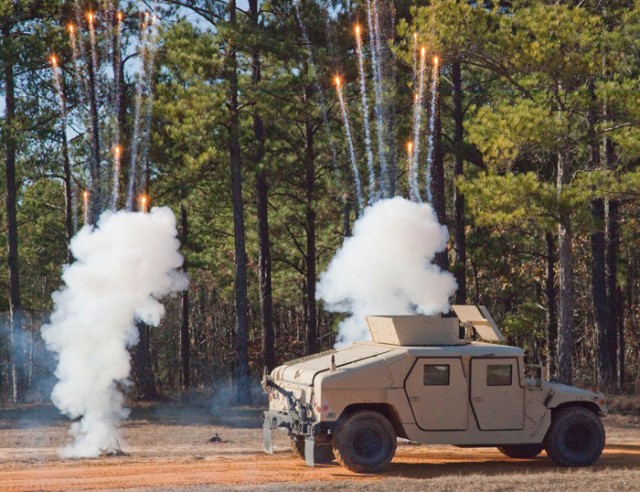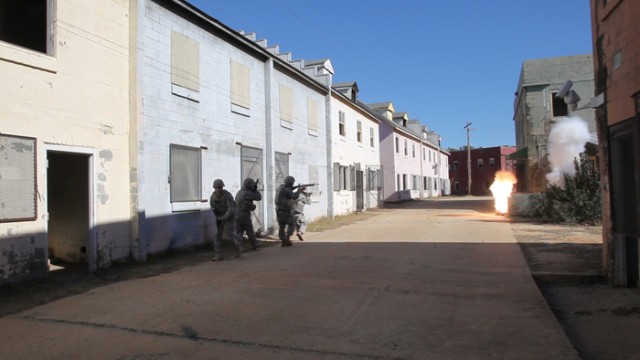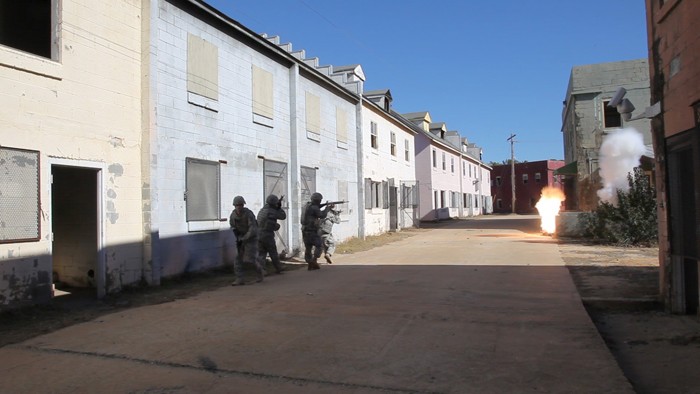FORT BENNING, Ga. -- In an effort to stem accidents and keep troops from making their own simulator devices in roadside bomb training, the Army is producing a short safety awareness video set for release this summer.
The film will feature footage shot at Fort Benning, Ga., Dec. 13-15, with Fort Benning Soldiers, vehicles and ammunition. U.S. Army Forces Command is heading the project, while the Soldier Requirements Division and Maneuver Battle Lab served as host organizations during shooting.
Larry Baker, FORSCOM safety manager for Ammunition, Explosives and Ranges, said the goal is to promote the Army's family of approved devices and ammunition for improvised explosive device (IED) simulator training. The scenes will reflect feedback from Soldiers and contractors in Afghanistan and Iraq.
"It's more of an awareness piece and not designed as an instructional video," Baker said. "It's not your traditional training film. The realism is based on realistic scenarios from combat."
While setting up IED training lanes, Soldiers sometimes engage in unsafe practices, without realizing the consequences, said Justin Strayer, a close combat systems analyst for the Soldier Requirements Division. Hazards associated with creating IED simulators are among the Army's top safety concerns. Injuries can include burns, lost fingers, hearing loss, eye and fragmentation injuries, and concussions.
"They'll try to make it as realistic as possible, and it's dangerous," Strayer explained.
Fireworks and gasoline are just two ingredients in a "witch's brew" of items available for purchase, Baker said.
"They're trying to do the right things and follow orders in some cases to arrange an authentic training scenario, but you wind up with an injured Soldier," he said. "Our video is an education tool that presents an overview of what's out there for safe use."
"People do take shortcuts, but we'll try to eliminate that," said Baker. "And it's not just the Army that uses this. These are joint-service munitions available to all branches and all federal agencies."
The three-day shoot involved the Army Armament Research Development and Engineering Center, Project Manager Training Device, simulator program managers, FORSCOM safety officials and Pacific Coast Systems, a major manufacturer.
Meanwhile, four Soldiers from Fort Benning's 789th Explosive Ordnance Disposal Company took part in the mounted, dismounted and vehicle situations as actors.
"I know I never want to be an actor in Hollywood after this," joked Spc. Andrew Barnes. "We were doing the exact same thing over and over again so they could get the right shot. It's kind of like making a movie."
But this film contains an important message for all Soldiers, he said.
"Instead of trying to make their own (IED) devices, there are safer alternatives," Barnes said.
Spc. James Bridges said he hopes the video has a wide impact.
"It should help stop people from getting hurt," he said. "These things are quicker and safer to set up, and the effects are a lot more realistic."
Baker said up to 3,000 copies will be part of the DVD's initial release in June across the Army. It's set to include an interactive menu and be posted on several Army safety websites.
The video is the second in a series produced by the ARDEC, Munitions New Equipment Training and Media Production Branch. The Picatinny Arsenal, N.J.-based group came out with Pyrotechnic Simulator Safety in October of 2009.
Since then, incidents with hand-grenade and hand-held artillery simulators Armywide have dropped from two or three a month to zero, Strayer said.
"As simple as this is, when you reduce incidents like that, a five-minute video can be priceless," he said.
IED SIMULATORS
The Army has a batch of safety-approved devices and ammunition for improvised explosive device simulator training. They're triggered by remote control, command wire or pressure plate and can simulate various "blast" sizes. The list includes:
Battlefield Effects Simulator (BES) Omega 60
Improvised Explosive Device Effects Simulator (IEDES)
M30 Main Tank Gun Simulator
M31A1 Direct/Indirect Fire Cue
Self-Contained Portable Improvised Explosive Device Simulator, or SCOPIS
MPT-30
155/2 Joint Artillery Counter IED Trainer
FOX
Under Vehicle Explosive Device (UVED)
M34 Hostile Fire Simulator
M35 Target Hit (White Star) Simulator
Related Links:
STAND-TO!: Counter-Improvised Explosive Device Integration Cells




Social Sharing